If your rhubarb plants are dying, you’re going to want to figure out why as soon as you can, so you can fix the issue. Luckily, most things that cause rhubarb to die can be fixed with simple, at-home methods.
In this post, I’ll talk about the most common causes of rhubarb plants dying, and what you can do about each of them.
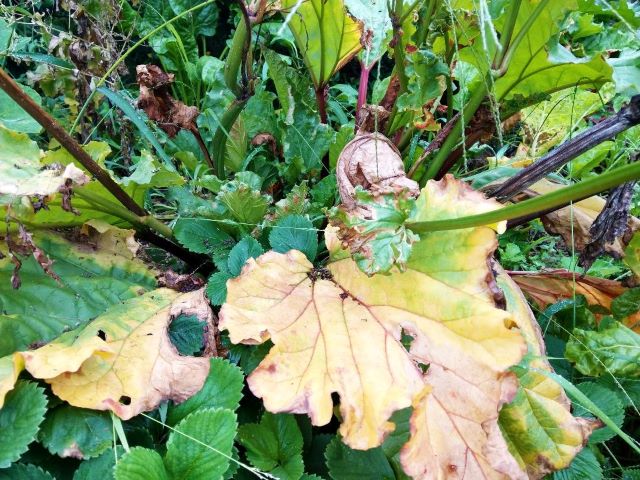
The most common causes for rhubarb dying are: overwatering, poor soil aeration, too much heat, iron deficiency, or pests and diseases.
So what are the solutions to these problems? Read on to find out more.
Table of Contents
Rhubarb Dying Due to Overwatering
If your rhubarb has been overwatered, its leaves will yellow and start to wilt. This is a good sign that the plant has had too much water. This can also lead to root rot, which I’ll talk about more later on.
When you notice this, the best thing to do is to simply water your rhubarb less. Allow the soil to dry out a bit so the plant can recover, then resume normal watering.
In general, you want rhubarb plant soil to remain moist, but not waterlogged. The soil shouldn’t dry out completely between waterings, but it shouldn’t constantly be very wet. A low level of moisture is ideal for rhubarb.
Also, make sure the soil your rhubarbs are in is well-draining. If it isn’t, more water will sit around the roots, which can cause damage.
Rhubarb Dying Due to Poor Soil Aeration
Rhubarb has very sensitive roots, which both need to not be waterlogged and have a good supply of air. Soil aeration, or the amount of air which can flow through the soil, is important to get right.
For this reason, loamy soils work the best for rhubarb. This is a lighter type of soil, and will allow plenty of aeration and prevent rhubarb roots from being smothered. If your rhubarb plants are in a heavier soil, like one full of clay or other heavy materials, try replacing it with a loamier mix. The best way to do this is to mix in organic compost, peat moss, or other organic matter.
Rhubarb Dying Due to Leaves Getting Scorched
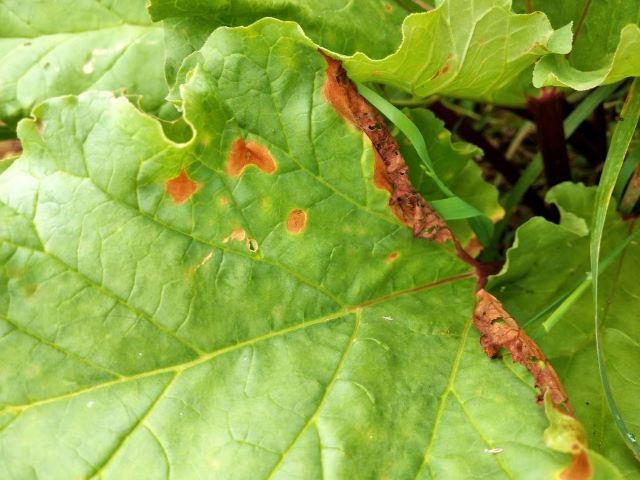
Although rhubarbs are quite heat-tolerant, they are not immune from sunburn. The ideal heat range for rhubarb plants is between 45-75 °F (7-24 °C). If it gets hotter than that, there can be problems.
Like I said, rhubarbs are tolerant of heat, and will often be ok at temperatures above 75 °F (24 °C). However, make sure they get plenty of water and at least partial shade. If they don’t have both of these things, it’s more likely that the plant will get damaged.
Scorched leaves, which turn white or brown, or even just leaves that are very droopy, are a sign of overheating. If you water them quickly, and give them more shade, they will bounce back in no time.
Rhubard Dying Due to Iron Deficiency
When there’s not enough iron in the soil, rhubarb leaves will turn yellow and start to wilt, eventually leading to the plant dying. Because this can be similar to the symptoms of overwatering, the best way to determine between the two is to do a pH test of the soil.
Soil that’s low in iron will have a pH that is higher than normal, meaning above 6.5. If the rhubarb soil pH is high, adding more iron to the soil is necessary to help the plants recover.
An organic mix of chelated iron will work great for this. Simply follow the instructions on the package and your rhubarb will be back on the road to health.
Rhubarb Dying Due to Pests Attack
Luckily, pests aren’t a huge problem for rhubarb plants. You should, however, be on the lookout for snails and slugs, as these critters are the most common rhubarb pests.
Slugs and snails will snack on rhubarb leaves, leaving holes that you can see. Depending on the size of the plant and how many pests you have, this could be a bad thing. Larger plants that have only a few slugs won’t be too damaged by the pests, and they’ll likely just be a nuisance.
For smaller plants, or larger infestations, though, snails and slugs can be deadly to rhubarb. If they eat too much of the plant, it won’t be able to survive. So you might have to get rid of them.
To get rid of these pests is quite simple. First, make sure there are no weeds around your rhubarb, as this provides them with shelter. Then, simply remove all the slugs and snails you see by hand, taking them somewhere where they won’t bother your rhubarb anymore.
If you don’t want to pick up these pests by hand, you can always set traps for them. A shallow bowl half-filled with beer is a timeless classic: the yeast will attract the snails and slugs, and then they will drown.
Alternatively, you can use an organic, plant-safe snail and slug killer. Any of these options can get rid of slugs and snails in your garden. Which one you choose depends on whether or not you want to kill the pests, and how much time you can put into dealing with them.
Rhubarb Plant Dying Due to Disease
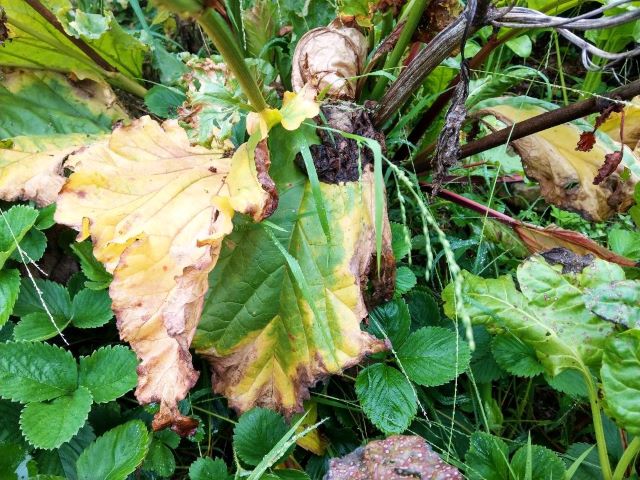
Rhubarb is a very hardy plant, and is resistant to a lot of diseases. So you won’t commonly see rhubarb diseases in your garden, but there are a few fungal diseases you should know how to identify.
Fungal diseases are very difficult to treat, and often the only solution is to remove infected parts of the plant, or whole rhubarb plants, to prevent them from spreading. Additionally, fungi thrive on moisture, so you can help avoid these diseases by not getting the leaves wet and not overwatering your rhubarb.
There are some natural methods you can try to treat rhubarb fungal diseases, if you catch them soon enough. Combining baking soda, dish soap, and water in a spray bottle and using that to spray the plants could help kill the fungus. You can also try mixtures involving corn meal, chamomile tea, or even cinnamon.
However, these natural methods won’t always work, especially if you don’t catch the disease very early. In that case, you have two options: you can turn to non-organic fungicides, of which there are many, or you can remove the infected plants.
Many fungicides are made from copper, sulfur, tin, or mercury. Some also use carbon as their main base. All of them can be effective, but aren’t organic and may be harmful to other things in your garden as well as the environment in general.
Root and Crown Rot in Rhubarb Plants
As I mentioned before, root rot is often caused by overwatering of rhubarb. When this happens, it allows a fungus (commonly Botrytis) to grow in the soil around the roots, damaging the plants.
This causes rhubarb roots to turn black and mushy, and causes the leaves to wilt, eventually killing the plant. Rhubarb can also get crown rot, which is very similar but affects the crown of the plant; along with wilting leaves, the crown will turn brown and mushy.
To help prevent this, use a well-draining soil and don’t overwater. If rot does set in, it’s best to remove the plant and replace the soil. If you can’t do that, then avoid planting more rhubarb in that soil for a while, to allow the fungus to die off.
Ascochyta Leaf Spot on Rhubarb
This fungus causes green-yellow spots to appear on rhubarb leaves, which will eventually spread and unite into larger lesions. As they grow, they will have white centers and reddish edges, and finally will turn brown and fall out, leaving holes in the plant.
If you notice this, remove the infected leaves immediately to prevent it from spreading. If necessary, remove entire plants from the garden, and make sure not to let them touch the healthy ones.
Rhubarb With Ramularia Leaf Spot
Small red spots on rhubarb leaves are the first sign of this fungus. They will grow, becoming tan or white with purplish edges. Eventually, they become sunken legions and spread to the stalk of the rhubarb.
Once again, remove infected parts, or entire plants, immediately. This fungus can kill plants quickly, so you need to do everything you can to prevent it from spreading to the rest of your garden.
What Should a Healthy Rhubarb Plant Look Like?
With all that talk of dying rhubarb plants, you might be interested to know what healthy rhubarb should look like. So below are a couple of photos to show you.
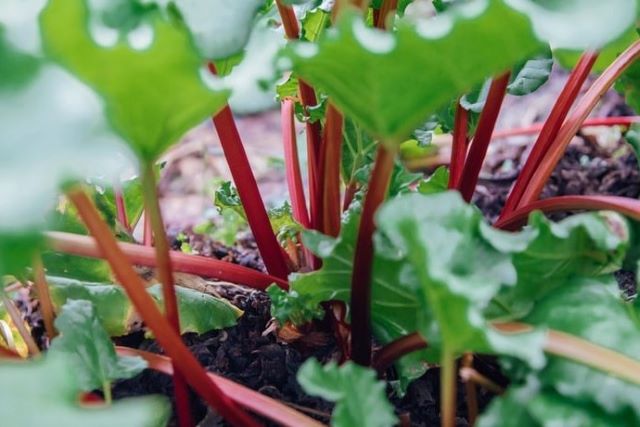
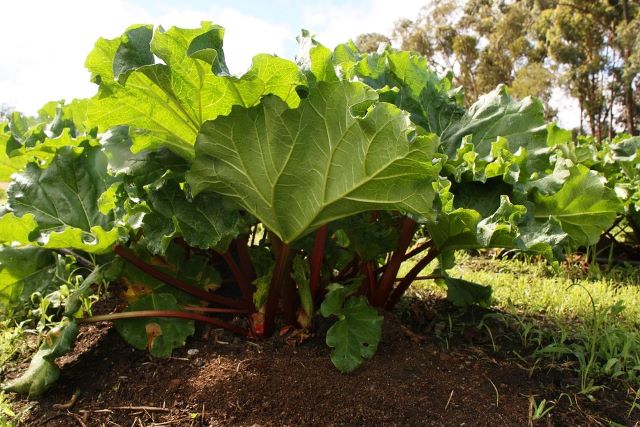
Further reading:
